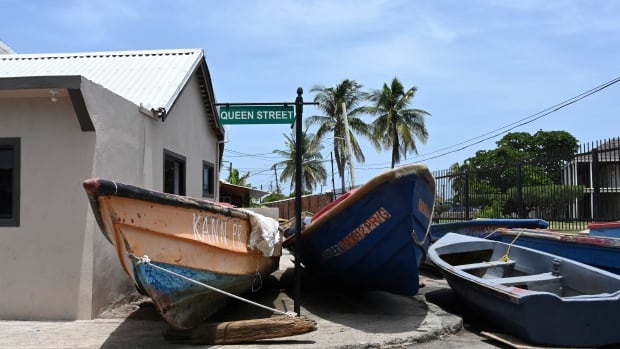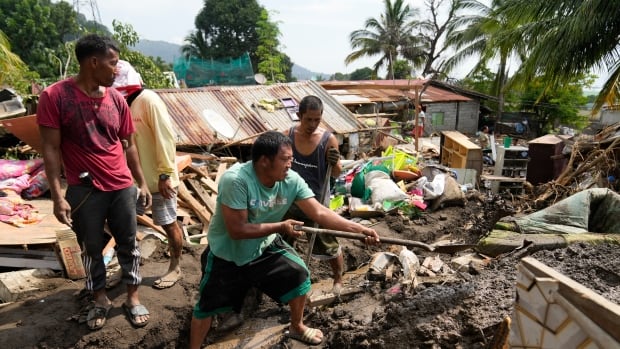Hurricane Beryl was roaring toward Jamaica on Wednesday, with islanders scrambling to make preparations after the powerful Category 4 storm earlier killed at least six people and caused significant damage in the southeast Caribbean.
In Kingston, people boarded up windows, fishermen pulled their boats out of the water before sitting around a table to play dominoes beside a bay, and workers dismantled roadside advertising boards to protect them from the expected lashing winds to come.
A hurricane warning was in effect for Jamaica, Grand Cayman, Little Cayman, and Cayman Brac. Beryl was losing intensity but was forecast to still be near major-hurricane strength when it passes near or over Jamaica on Wednesday, near the Cayman Islands on Thursday and into Mexico’s Yucatan Peninsula on Friday, according to the Miami-based National Hurricane Center.
A hurricane watch was in effect for Haiti’s southern coast and the Yucatan’s east coast. Belize issued a tropical storm watch stretching south from its border with Mexico to Belize City.
Late Monday, Beryl became the earliest storm to develop into a Category 5 hurricane in the Atlantic and peaked at winds of 270 kilometres per hour Tuesday before weakening to a still-destructive Category 4.
Pauline Edie, who lives in Kingston, Jamaica, says she has stocked up on non-perishables ahead of Hurricane Beryl. Edie, who has lived through major storms before, says she’s got food, water and family close — but she’s urging those in less secure situations to head to higher ground.
Early Wednesday, the storm was about 300 kilometres east-southeast of Kingston, Jamaica. It had top winds of 230 km/h and was moving west-northwest at 31 km/h, the centre said.
Beryl was expected to bring life-threatening winds and storm surge to Jamaica, where officials warned residents in flood-prone areas to prepare for evacuation.
“I am encouraging all Jamaicans to take the hurricane as a serious threat,” Prime Minister Andrew Holness said in a public address Tuesday. “It is, however, not a time to panic.”
Jamaica in path of storm
In Miami, National Hurricane Center director Michael Brennan said Jamaica appears to be in the direct path of Beryl.
“We are most concerned about Jamaica, where we are expecting the core of a major hurricane to pass near or over the island,” he said in an online briefing. “You want to be in a safe place where you can ride out the storm by nightfall [Tuesday]. Be prepared to stay in that location through Wednesday.”
Storm surge of 1.8 to 2.7 metres above typical tide levels are likely in Jamaica, as well as heavy rainfall.
“This is a big hazard in the Caribbean, especially with the mountainous islands,” Brennan said. “This could cause life threatening flash floods and mudslides in some of these areas.”
A tropical storm warning was in place for the entire southern coast of Hispaniola, an island shared by Haiti and the Dominican Republic.
On Tuesday, the Canadian government urged Canadians to avoid travelling to Haiti and other Caribbean nations due to the threat posed by the hurricane.
Jamaica is now under curfew from 6 a.m. to 6 p.m. and its international airports are closed. Three planes chartered on Tuesday by Air Transat to repatriate customers from Montego Bay, due to the storm, arrived in Canada early Wednesday, two in Montreal and one in Toronto.
Global Affairs Canada (GAC) advised Canadians to avoid “all travel” to Haiti as well as “all non-essential travel to the Cayman Islands, Jamaica, Union Island in St. Vincent and the Grenadines and to Carriacou and Petite Martinique in Grenada” in a statement issued Tuesday evening.
People on Union Island in St. Vincent and the Grenadines were picking through rubble earlier this week after Hurricane Beryl slammed the region, with government officials saying preliminary reports suggest over 90 per cent of the island’s infrastructure was damaged.
According to GAC, there are 3,162 Canadians registered in Haiti; 1,524 in the Cayman Islands; 1,625 in Jamaica; 236 in St. Vincent and the Grenadines and 341 in Grenada.
Trail of devastation
As the storm barrelled through the Caribbean Sea, rescue crews in southeastern islands fanned out to determine the extent of the damage Beryl inflicted on Carriacou, an island in Grenada.
Three people were reported killed in Grenada and Carriacou and another in St. Vincent and the Grenadines, officials said. Two other deaths were reported in northern Venezuela, where five people are missing, officials said. Some 25,000 people in that area also were affected by heavy rainfall from Beryl.
One fatality in Grenada occurred after a tree fell on a house, Kerryne James, the environment minister, told The Associated Press.
She said Carriacou and Petit Martinique sustained the greatest damage, with scores of homes and businesses flattened in Carriacou.
“The situation is grim,” Grenadian Prime Minister Dickon Mitchell told a news conference Tuesday.
“There is no power, and there is almost complete destruction of homes and buildings on the island. The roads are not passable, and in many instances they are cut off because of the large quantity of debris strewn all over the streets.”
Meanwhile, Ralph Gonsalves, prime minister of St. Vincent and the Grenadines, noted that 90 per cent of homes on Union Island were destroyed, and that “similar levels of devastation” were expected on the islands of Myreau and Canouan.
The last strong hurricane to hit the southeast Caribbean was Hurricane Ivan 20 years ago, which killed dozens of people in Grenada.
Hundreds of people hunkered in shelters across the southeast Caribbean, including 50 adults and 20 children who huddled inside a school in Grenada.










